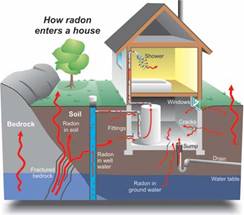

|
FAMU/FSU College of Engineering |


|
Radon poses serious health risks if exposed to levels over 4 piC/L over long periods of time. |
|
Project Description |
|
Radon is a harmful radioactive gas that occurs naturally from the decay of uranium in the soil. Being colorless, odorless, and tasteless, it is only detectable by way of radon testing. It is found all over the world and according to the Environmental Protection Agency (EPA), it kills over 20,000 people each year which makes it the leading cause of lung cancer among non-smokers. Radon can seep into any kind of structures, homes, schools, hospitals and accumulate until it causes serious health risks. There have even been reports of dangerous levels of radon on the upper levels of high-rise residential buildings. Since the traditional mitigation techniques cannot be implemented on already existing buildings, ventilation must be used to dilute the radon out of the individual units. Here lies a problem in that it is unknown to the mitigators the size of the ventilation system required to dilute the radon to a safe level. Our spreadsheet gives the amount of airflow necessary for a particular unit to bring the radon down to a safe level. Project Scope: Develop a spreadsheet tool to evaluate the parameters necessary for successful mitigation of a single unit within a multi-family structure using ventilation techniques. |



